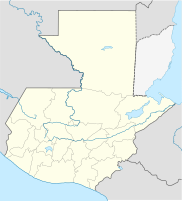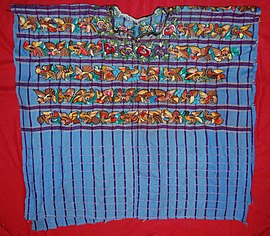Santiago Atitlan
| Santiago Atitlan | ||
|---|---|---|
|
Coordinates: 14 ° 38 ′ N , 91 ° 14 ′ W Santiago Atitlán on the map of Guatemala
|
||
| Basic data | ||
| Country | Guatemala | |
| Department | Sololá | |
| City foundation | 1524 | |
| Residents | 26,000 | |
| - in the metropolitan area | 45,000 | |
| Detailed data | ||
| surface | 136 km 2 | |
| Population density | 191 inhabitants / km 2 | |
| Time zone | UTC −6 | |
| Santiago Atitlán - Maximón | ||
| Wedding poncho for men of the Tzutuhil . Woven and high quality by hand, embroidered on both sides by the bride for the groom . Working time 6 - 8 weeks. | ||
Santiago Atitlán is a city above the shore of a bulge in the south of Lake Atitlán in the highlands of Guatemala .
location
The place lies at the foot of the two volcanoes Tolimán (3,144 m) and Atitlán (3,516 m) and was previously hardly accessible by land - volcanic mountains and lake formed a natural barrier, which was only opened towards the end of the 20th century by the construction of a road was overcome. Until then, the main connection to the outside world was via boats, which connected the villages and communities on the lake shore with one another or with the most important settlement on the northeast shore, Panajachel .
population
Santiago Atitlán, with a population of more than 25,000, is mostly inhabited by Indians of the Maya tribal group of the Tzutuhil ; Minorities are members of the Cakchiquel and Quiché Maya. The remote location of the place favored the survival of pre-Christian ways of life and thought as well as old beliefs.
Some women show the tourists how a formerly typical headgear consisting of a 6 cm wide but several meters long ribbon is wrapped; A very similar headgear can be found in several sculptures (altar Q, stele B) in the classic Mayan site of Copán ( Honduras ). The Tzutuhil differ from the Cakchiquel on the north side of Lake Atitlan because of the white base tone of many items of clothing.
religion
In addition to remnants from the broad spectrum of Mayan religious ideas and the Catholicism practiced for about 500 years, North American evangelical sects have spread since the 1980s . In many places, their teachings fall on fertile ground among the Indians who have been disappointed by the Catholic Church . In addition, these sects have large financial resources that are used for development projects, but also for building large prayer halls.
Surname
The name Atitlán comes from Nahuatl , which is not spoken here, but in central Mexico , where atitlan means "place with a lot of water" or "place in the middle of water" ( atl "water" and -titlan "in the middle"). The equivalent in the Tzutuhil language is Chiyá or Chi 'Ya' , which is also the old name of the ruins of Chuitenamet (Chuitinamit) near San Pedro. The name Atitlán was also transferred to Lake Atitlán. It is not known when the Nahuatl names introduced by the Spaniards through the mediation of the allied Tlaxcalteks superseded the old Tzutuhil names. The Tzutuhil name of today's place Santiago Atitlán is Tz'ikin Jaay , "House of Birds".
history
The fertile area around Lake Atitlán was already settled in pre-Columbian times. Around the year 1000, a place called Chukumuk or Xicomuk is mentioned, whose inhabitants, however, were not Maya, but probably - corresponding similarities of ceramic shards suggest this - Nahuatl- speaking pipiles who immigrated from today's Mexico .
Santiago Atitlán was founded in 1524 by the Spaniards, who settled the main part of the Tzutuhilen tribe there after the destruction of the old capital Chuitinamit at the foot of the volcano San Pedro (2,846 m) . In the 1980s and 1990s civil unrest broke out, some of which were bloodily suppressed by Guatemalan army units. In October 2005, the hurricane 'Stan' triggered enormous rainfalls and mudslides , which destroyed many houses in the village and the corn fields ( milpas ) on the mountain slopes and also cost the lives of over 70 people.
Attractions
- The street from the boat landing up to the city center is lined with stalls with colorful products of all kinds - here you will find woven and embroidered clothes, bags and blankets etc. as well as pictures, ceramics and the like. a. Some women wear the already mentioned 'hat', which in the past also served to protect against strong sunlight; a tip is expected for photos.
- In the city center, the colonial church rises up with a rather simple facade. On the side walls of the interior there are figures of saints of different sizes, but without any hierarchical gradation. Overall, however, the church makes a much more tidy, if less atmospheric impression than the main church of Santo Tomás of Chichicastenango .
- A visit to the local saint Maximón should not be missed, even if tourists are asked to pay for admission and photos.
- A look into one of the evangelical houses of worship may also be of interest.
literature
- Wolfgang Gockel : Guatemala, Belize, Honduras and El Salvador. DuMont, Cologne 1999, pp. 154ff, ISBN 3-7701-4732-4 .
Web links
- Santiago Atitlán, website of the city - photos + information (English)
- Santiago Atitlán - Video (Spanish)
- Santiago Atitlán - Photos + Info (English)
Individual evidence
- ^ Charles H. Long: Introduction: Entering the Atiteco World of Santiago Atitlan . In: James Vincent Stanzione, Paul Harbaugh, Angelika Bauer: Rituals of Sacrifice: Walking the Face of the Earth on the Sacred Path of the Sun . University of New Mexico Press, Albuquerque 2003. p. 1.
- ↑ Tz'unun Ya '? , tzununya.com


